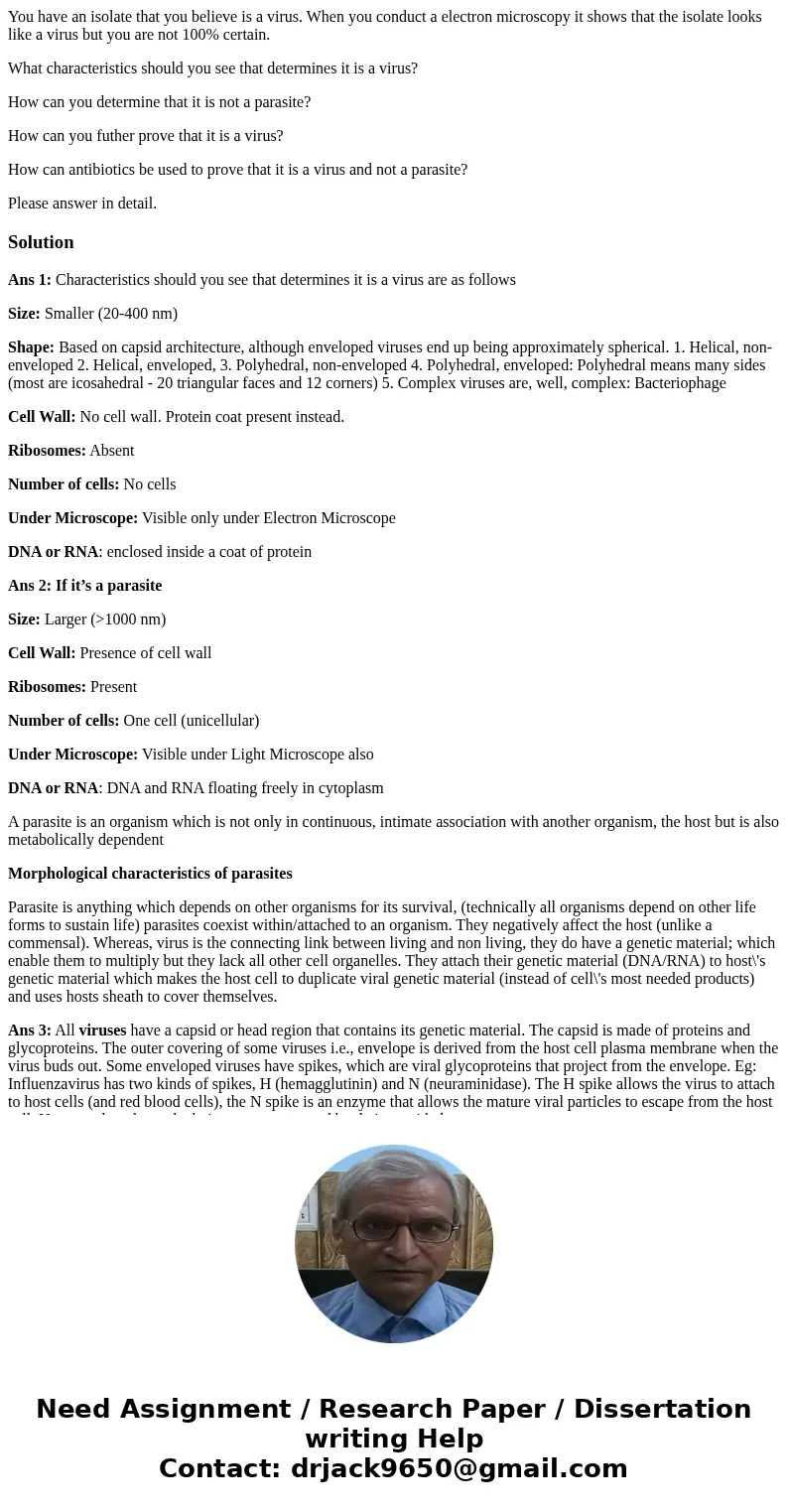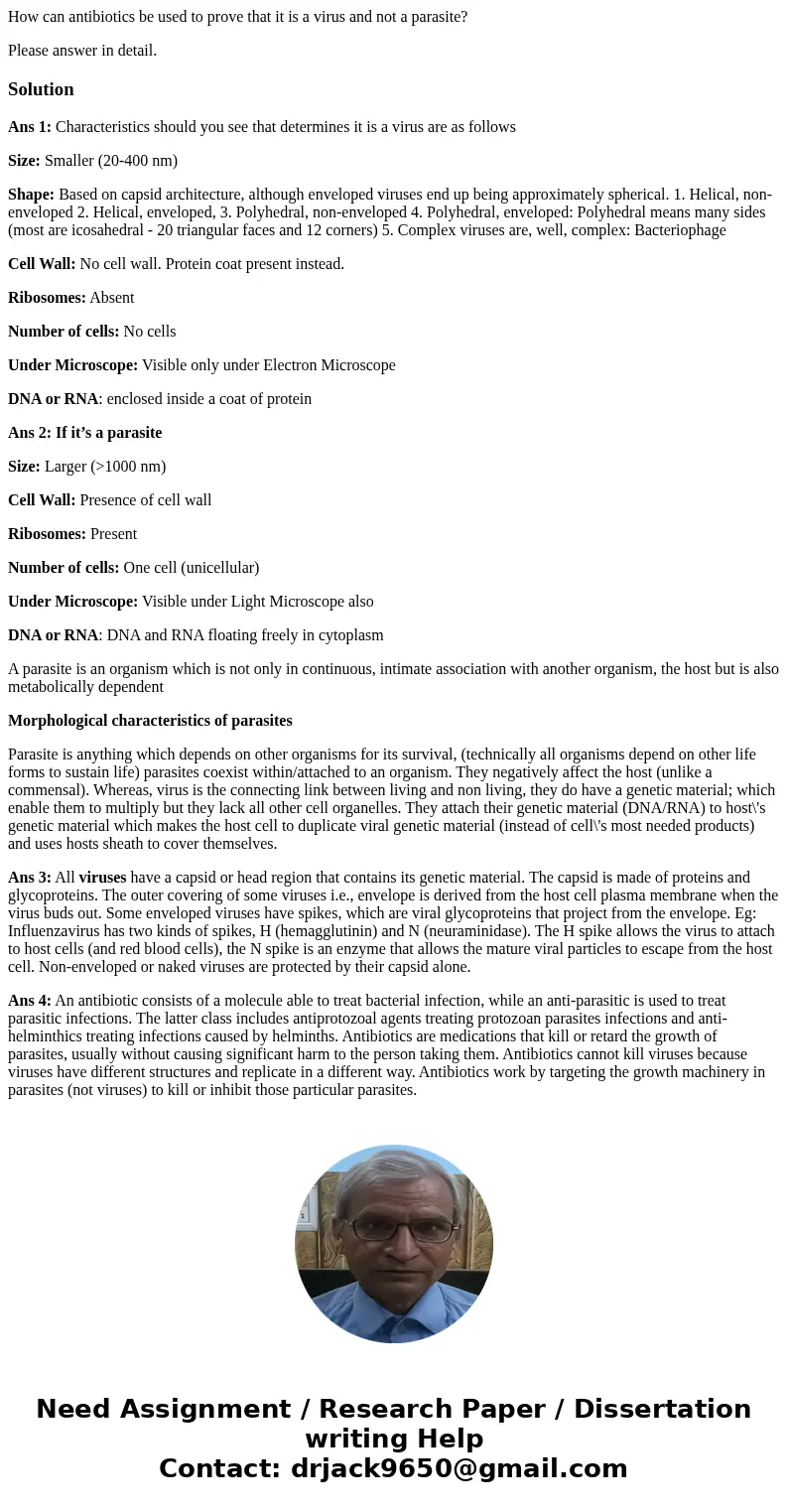You have an isolate that you believe is a virus When you con
You have an isolate that you believe is a virus. When you conduct a electron microscopy it shows that the isolate looks like a virus but you are not 100% certain.
What characteristics should you see that determines it is a virus?
How can you determine that it is not a parasite?
How can you futher prove that it is a virus?
How can antibiotics be used to prove that it is a virus and not a parasite?
Please answer in detail.
Solution
Ans 1: Characteristics should you see that determines it is a virus are as follows
Size: Smaller (20-400 nm)
Shape: Based on capsid architecture, although enveloped viruses end up being approximately spherical. 1. Helical, non-enveloped 2. Helical, enveloped, 3. Polyhedral, non-enveloped 4. Polyhedral, enveloped: Polyhedral means many sides (most are icosahedral - 20 triangular faces and 12 corners) 5. Complex viruses are, well, complex: Bacteriophage
Cell Wall: No cell wall. Protein coat present instead.
Ribosomes: Absent
Number of cells: No cells
Under Microscope: Visible only under Electron Microscope
DNA or RNA: enclosed inside a coat of protein
Ans 2: If it’s a parasite
Size: Larger (>1000 nm)
Cell Wall: Presence of cell wall
Ribosomes: Present
Number of cells: One cell (unicellular)
Under Microscope: Visible under Light Microscope also
DNA or RNA: DNA and RNA floating freely in cytoplasm
A parasite is an organism which is not only in continuous, intimate association with another organism, the host but is also metabolically dependent
Morphological characteristics of parasites
Parasite is anything which depends on other organisms for its survival, (technically all organisms depend on other life forms to sustain life) parasites coexist within/attached to an organism. They negatively affect the host (unlike a commensal). Whereas, virus is the connecting link between living and non living, they do have a genetic material; which enable them to multiply but they lack all other cell organelles. They attach their genetic material (DNA/RNA) to host\'s genetic material which makes the host cell to duplicate viral genetic material (instead of cell\'s most needed products) and uses hosts sheath to cover themselves.
Ans 3: All viruses have a capsid or head region that contains its genetic material. The capsid is made of proteins and glycoproteins. The outer covering of some viruses i.e., envelope is derived from the host cell plasma membrane when the virus buds out. Some enveloped viruses have spikes, which are viral glycoproteins that project from the envelope. Eg: Influenzavirus has two kinds of spikes, H (hemagglutinin) and N (neuraminidase). The H spike allows the virus to attach to host cells (and red blood cells), the N spike is an enzyme that allows the mature viral particles to escape from the host cell. Non-enveloped or naked viruses are protected by their capsid alone.
Ans 4: An antibiotic consists of a molecule able to treat bacterial infection, while an anti-parasitic is used to treat parasitic infections. The latter class includes antiprotozoal agents treating protozoan parasites infections and anti-helminthics treating infections caused by helminths. Antibiotics are medications that kill or retard the growth of parasites, usually without causing significant harm to the person taking them. Antibiotics cannot kill viruses because viruses have different structures and replicate in a different way. Antibiotics work by targeting the growth machinery in parasites (not viruses) to kill or inhibit those particular parasites.


 Homework Sourse
Homework Sourse